Introduction
Congonhas Airport in Sao Paulo, Brazil, is infamous for the deadliest airplane crash in Brazil’s history. On July 17, 2007, TAM Airlines Flight 3054 ran off the runway upon landing and crashed into the nearby warehouse that belonged to TAM (CENIPA 2009). The resulting collision ended in the deaths of all the plane passengers and crew as well as 12 individuals in the warehouse, bringing the total casualty number to 199 fatalities and 13 injuries (CENIPA 2009).
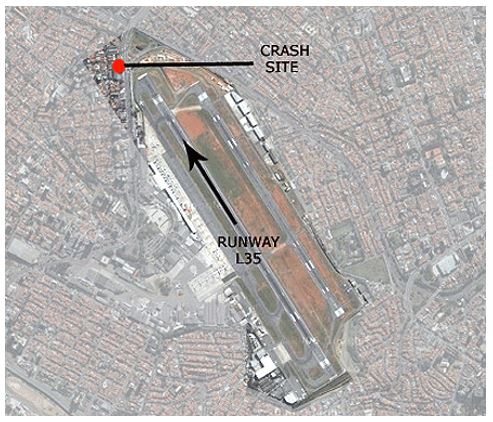
The investigation performed by the CENIPA (2009), the Brazilian Aeronautical Accidents Investigation and Prevention Centre, lasted for 2 years and had discovered numerous factors that have played the part in the tragedy. It was concluded that the crash happened because of the mistake of the pilots, caused by perception errors, loss of situational awareness, poor cockpit coordination, and insufficient levels of co-pilot training (CENIPA 2009). At the same time, the conditions on the ground played a major role in shaping and motivating the pilots’ actions as well as exacerbating the results of their failures. The catastrophe helped uncover a myriad of safety regulations failures at Congonhas Airport, which resulted in it losing its international airport status, significant decrease of lanes and serviceable flights, as well as a long period of flight restrictions during the night (7 hours). Effectively, Congonhas lost its place as the busiest airport in Brazil. Nevertheless, it remains the second-busiest airport up to date.
The purpose of this paper is to evaluate the airport conditions during the crash and 13 years after. The differences will highlight the areas of improvement being made, and what else needs to be done. It will conclude with a set of recommendations based on the provided evidence to further increase the safety of planes in the runway.
Evaluation of Airport Conditions on July 17, 2007
Runway Conditions
Congonhas Airport is notorious for being located in the tropical climate zone, which brings about frequent and heavy rainfalls (See Fig. 2). The rain causes the formation of puddles and slippery surfaces on the runway, which may extend the full-stop brake distance for the plane in question by about 20% (CENIPA 2009). It may also cause the effect known as hydroplaning, which causes the plane to lose friction with the wet surface as a result of contact with water. Standard measures performed to reduce or eliminate the effects of excessive water on the runway include grooving and giving it sloped geometry to prevent rainfall from accumulating into puddles (CENIPA 2009). Grooving was being planned to be added to the runways but was not existent when the crash occurred despite the recent renovations done earlier in 2007 during the recent refit (CENIPA 2009). The slopes, while having been made, were erased by extensive rubber friction from planes landing and taking off, and did not perform their jobs adequately. As a result, the pilots were used to the runways being wet and slippery, and usually accounted for it when landing.
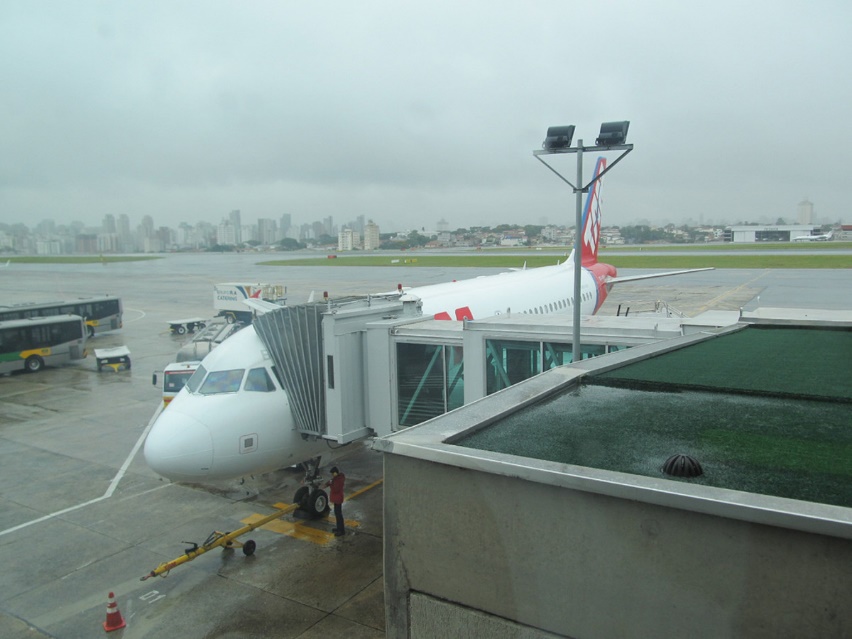
The administration of Congonhas Airport had a warning for the tragedy to come, as the day before a PLA flight 4763 suffered a hydroplaning accident, resulting in the plane veering off the runway and damaging itself against a concrete box and a light pole. While the passengers and the crew (25 people in total) remained largely unscathed, the plane was rendered inoperable (CENIPA 2009). The incident was disregarded and hidden under wraps, but demonstrated the likelihood of wet surfaces affecting the landing procedures. Thus, a potential warning was ignored, and operations were continued. Had the airport been closed, TAM Airlines Flight 3054 tragedy would not have happened.
Runway Location and Architecture
Congonhas Airport is notorious for being located in the suburbs of Sao Paulo, surrounded by tall buildings. Being one of the oldest airports in Brazil, the issue was not present at the beginning, when it was just constructed (CENIPA 2009). However, the expansion of the capital outwards created numerous obstacles for planes. Frequent flyers report that landing in Congonhas feels like scraping the rooftops of these buildings (See Fig. 3). This results in a steeper angle of approach and harder potential landings because of it. In addition, due to being surrounded by various structures, the city restricts the space available for expanding the airport. The prices for land are much higher than in most other cities of Brazil, making the extension of the airfield an economically-daunting task (Pacheco et al. 2020).
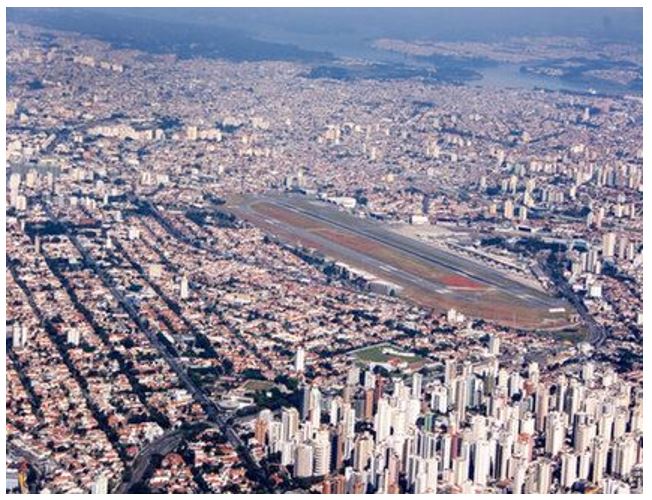
This brings about the second major issue that Congonhas airport had during the crash, that being a notoriously short runway. The 35L runway length was, at the time, at 1945 meters long, whereas the auxiliary 35R was only 1435 meters long (CENIPA 2009). For comparison, the average runway for widebody aircrafts, as per the standards of international airports, is at 2400 meters (CENIPA 2009). Pilots often described Congonhas Airport as being an ‘aircraft carrier’ due to how short and narrow the landing strips were. The shortness of the runway meant there was not enough space for the runway end safety area (RESA), which was not present on either of the runways, in direct violation of Annex 14 ICAO standard (CENIPA 2009).
Finally, there was the issue of vulnerable buildings and structures located in close proximity to the runway (see Fig. 4). This included the TAM warehouse, which the plane collided with, resulting in the death of 12 people on the ground. There was also a Shell filling station, which contained gas, oil, lubricants, and other flammable substances that, had the plane ran into it, would have resulted in an even larger fire and an explosion, potentially increasing the number of fatalities (CENIPA 2009). One of the reasons why the plane managed to reach this far was because the buildings were located below slope of the runway, giving the plane extra movement speed.
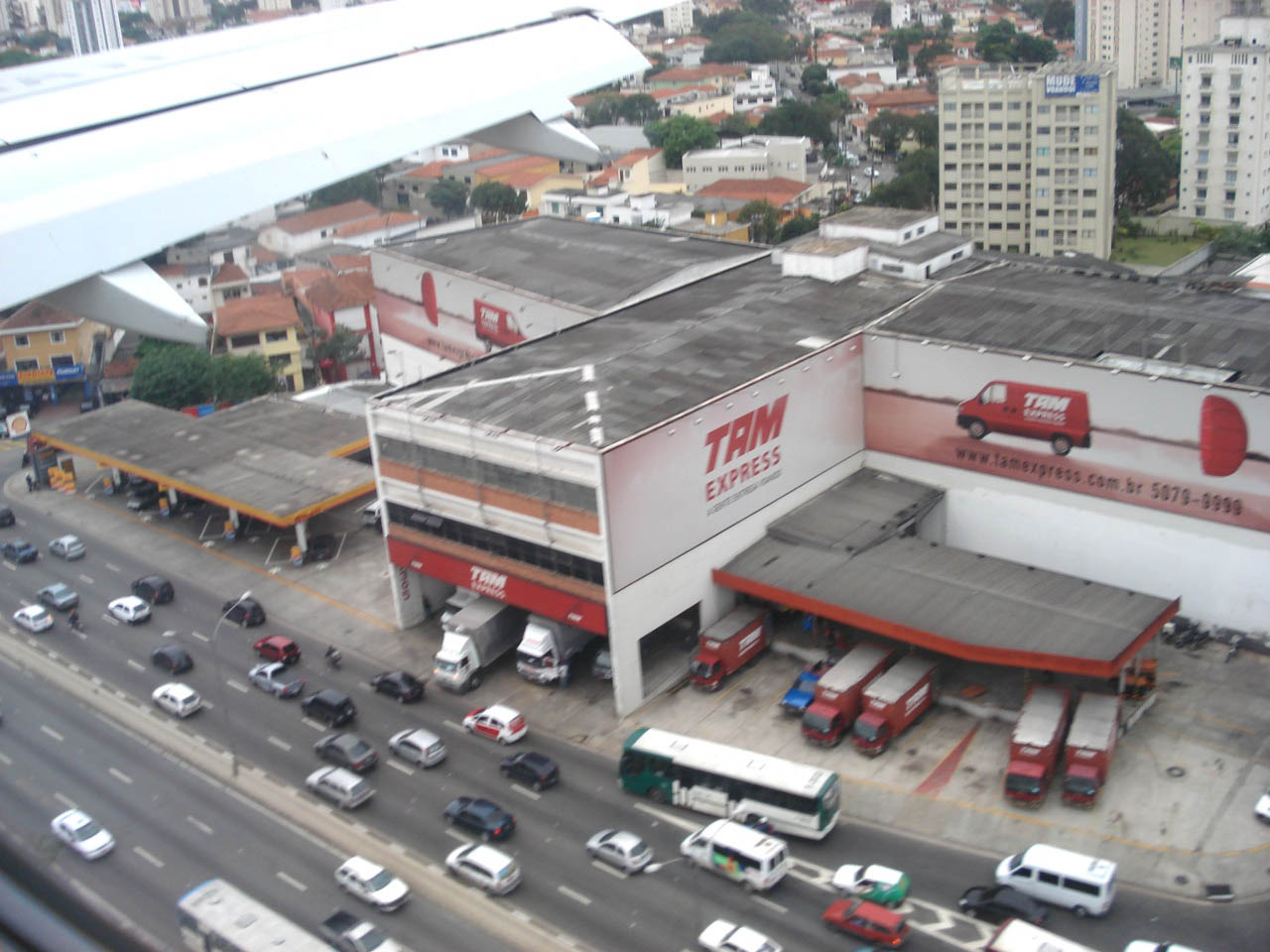
Management Planning and Oversights
Prior to the catastrophe, the operator of the plane had undergone a rapid expansion of its fleet and staff personnel numbers. As a result, they had too many captains and not enough co-pilots, so many planes were flown with elements of the crew having been retrained to fill in the new positions (CENIPA 2009). The minimum regulatory requirements were complied with, but the airport was complacent in letting too many co-pilots with very little actual co-piloting experience to fly and land planes, which may have had an effect in the TAM 3054 tragedy (CENIPA 2009). The airport officials routinely allowed TAM to compose the crew of two captains. The co-pilot had only the Right-Seat Certification training and less than 250 hours of flight experience (CENIPA 2009). The company operating out of Congonhas airport had poor cooperation between sectors in terms of coordination, training, and processes, which resulted in the higher likelihood of error during routine operations. Finally, although the availability of reversers was formalized as a requirement for airport operations and landing procedures as far as of April 2006, these requirements were not implemented at Congonhas airport until only after the tragedy had occurred (CENIPA 2009). Active compliance with such a requirement would have prevented the tragedy or at least increased the chances of stopping the plane before it collided with the building.
Changes Made and Persistent Issues at Congonhas Airport as of 2021
Between 2007 and 2009, CENIPA (2009) provided the authorities and operators of Congonhas airport with a number of recommendations to improve the safety standards of the airport and ensure that the tragedy of TAM 3054 would never happen again. These recommendations included limitations on operating flights, restrictions to narrow-hull planes with the mass of under 91 tons only, as well as numerous improvements to the quality of the runway. As of 2020, Congonhas airport has put some effort to rectifying the issues spotted by CENIPA. The improvements were as follows (Pacheco et al. 2020):
- Reduction of operational slots. Prior to the catastrophe, Congonhas was a notoriously busy airport, operating with no set limit and a high margin of 38 slots per hour. That number was reduced to 33 slots, with an average of two movements per hour on the L35 lane and four movements on the R35 lane.
- Organization of the routes and flight schedules was drastically improved, as was the operational sight of airlines. As of 2018, Congonhas has been implementing Zebra technologies to track vehicles and personnel on the runway (Dias 2020). In addition, planes with absent or inoperative reversers are prohibited from landing or taking off the airfield.
- All lanes now have drainage grooves, which help reduce the amount of water on the surface and improve friction. Also, as of 2021, Congonhas has been implementing an engineered material arresting system (EMAS), which allows for quick de-acceleration of aircraft in case of the landing strip being overrun (Dias 2020).
- Quality of training for operators and airport crew has been significantly improved, with the airport having direct responsibility and oversight over the quality and viability of certificates. Safety training and the use of reverse systems is being conducted on a regular basis.
- Main runway length was reduced to 1790 meters, and auxiliary one – to 1195 meters, with extra space being dedicated to RESA.
- Firefighter preparations and equipping were significantly improved.
- Congonhas airport requires its planes to use the EFB (Electronic flight bag), which provides the plane and its pilots with up-to-day information on the state of the runway, navigational charts, take-off, and landing performance calculations (Dias 2020). This technology allowed to significantly reduce the length of the runway required for plane landing, thus making landing safer.
As it is possible to see, Congonhas airport has implemented plenty of measures to improve safety and quality of the runways and associated airport systems, in accordance to CENIPA (2009) recommendations. Nevertheless, some issues remain. All of them relate to the overall length of the runway as well as RESA. According to Fortes and Correia (2018), the runway strip’s free obstacle area, which is currently at 300 meters of width and 60 meters of length from each threshold, is invaded by the apron and taxiway along its entire length (See Fig. 5). In addition, RESA is not sufficiently allocated for both runways, which may cause a disastrous catastrophe should an aircraft have a problem during its operation (Fortes and Correia 2018). Finally, the distance between the holding position and the runway axis is only 75 meters, meaning that a plane being refueled may become an obstacle during a veering-off incident similar to that of TAM 3054, and a collision will likely result in an explosion. The majority of these issues are systemic in nature, and are attributed to the airfield being old and initially constructed with much smaller planes in mind.
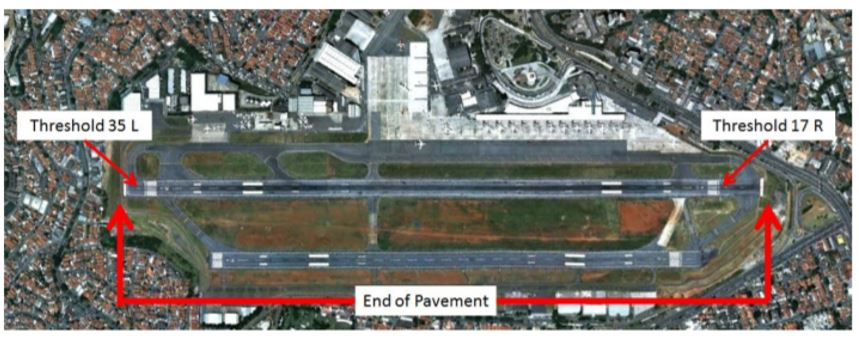
Recommendations
In terms of recommendations that could currently be made to help Congonhas improve its safety beyond what it has done already, there is not much room for improvement (Di Mascio et al. 2020). The length of the runway and RESA remains a prominent issue, and will likely continue to be such for any foreseeable future. While it is theoretically possible to expand 35L and 35R beyond its current limits, it would require inching into the living quartiles of the city, buying out the land, taking down buildings and communications, as well as potentially moving the road further away from the runway (Fortes and Correia 2018). As such, while it would have been preferable to expand the runway, there is no economically-feasible way to do so. Other recommendations mentioned in CENIPA report have already been made, leaving little to improve in that regard.
Nevertheless, Congonhas’ reduction of the actual runway length to extend the RESA was achieved solely through the widespread implementation of the EFB technology combined with the limitation of the airport to receiving narrow-hull planes. EFB, while effective and widespread as an alternative to paper-based information sources, is not without flaws. According to Chandra and Kendra (2019), EFB can be a contributing risk factor to landings and takeoffs, with the most frequently-cited issues being as follows:
- Spatial deviations – these are navigational errors from planned or scheduled routes;
- Runway incursions – obstacles not identified by the navigational computer appearing on the runway;
- Incorrect weight and balance computations – these can affect both the liftoff and landing calculations, potentially resulting in complications or even catastrophes;
- Expired databases – includes geographical locations, building heights, plane parameters, and more;
- Incorrect take-off speeds – may result in the plane hitting the ground with its tail upon rotation.
Most of these issues are caused by system bugs, faulty internet connections, and other factors related to clearance, checking, and maintenance at the airport level. Therefore, it is recommended to put the emphasis on the IT department of maintenance for the airport and operators (Bhardwajand Purdy 2019). All personnel related to EFB should be thoroughly instructed in using the models of EFB serviced on all flights accepted in Congonhas airport (Bhardwajand Purdy 2019). Databases should be frequently updated, and both captains and co-pilots should be familiarized not only in managing them, but also in spotting and overcoming any technical difficulties that could occur during flight.
Aside from EFB-based recommendations, Congonhas should keep a close watch and maintenance of the anti-puddle slopes and drainage grooves across the runway (Di Mascio et al. 2020). Part of the reason why the catastrophe happened in 2007 was because the slopes were erased by tires and the grooves were not present (CENIPA 2009). Likewise, without proper supervision and maintenance, the slopes might disappear, and the grooves may become clogged with dirt and litter, thus reducing the effectiveness of their draining functions.
Finally, Congonhas has to service narrow-hull planes with a weight capacity of under 91 tons, as prescribed by CENIPA (2009). If possible, the planes serviced should be as light as possible, with preference given to those with decreased requirements for runway length. It would help improve the safety of the existing runways without having to lengthen or expand them. Wide-hull planes should continue to be prohibited from landing in Congonhas to avoid any incidents similar to the Airbus crash. To further eliminate the chances of extra casualties in an event of a catastrophic failure, all hazardous facilities that could be hit by a plane veering off the runway should be placed away from the airport.
Conclusions
The conditions of Congonhas airport and the oversights in administrations and maintenance played a major role in the catastrophe of TAM Airlines Flight 3054 in 2007. Since then, Congonhas’ role has greatly diminished, but still remains important for regional and domestic travelling. The majority of the issues have since been partially or completely fixed, and the limitation of the number of flights in combination with narrow-hull planes helped significantly increase runway safety. The recommendations for improvement include emphasizing IT security in relation to EFB, frequent scheduled maintenance of drainage facilities, and continued restrictions on the size and weight of the planes received in the airport.
References
Aeronautical Accident Investigation and Prevention Center (CENIPA). (2009) FINAL
REPORT A – Nº 67/CENIPA/2009. Web.
Bhardwaj, P. and Purdy, C. (2019) ‘Safety and human factors for electronic flight bag usage in general aviation’, 2019 IEEE National Aerospace and Electronics Conference (NAECON), pp. 181-184.
Chandra, D. C. and Kendra, A. (2019) ‘Review of safety reports involving electronic flight bags’, International Symposium on Aviation Psychology, pp. 407-412.
De Castro Fortes, J. L. and Correia, A. R. (2018) ‘Safety assessment at airports: São Paulo/Congonhas airport–A case study’, Journal of Brazil Air Transportation Research Society, 8(1), pp. 29-42.
De Oliveira Dias, M. (2020) ‘Air transportation in Brazil: São Paulo Congonhas airport’, GSJ, 8(2), pp. 3244-3260.
Di Mascio, P., Cosciotti, M., Fusco, R. and Moretti, L. (2020) Runway veer-off risk analysis: an international airport case study. Sustainability, 12(22), p. 9360.
Pacheco, G., Camargo, M. and Halawi, L. (2020) ‘An evaluation of the operational restrictions imposed to Congonhas airport by civil aviation instruction 121-1013’, International Journal of Aviation, Aeronautics, and Aerospace, 7(2), pp. 11-25.